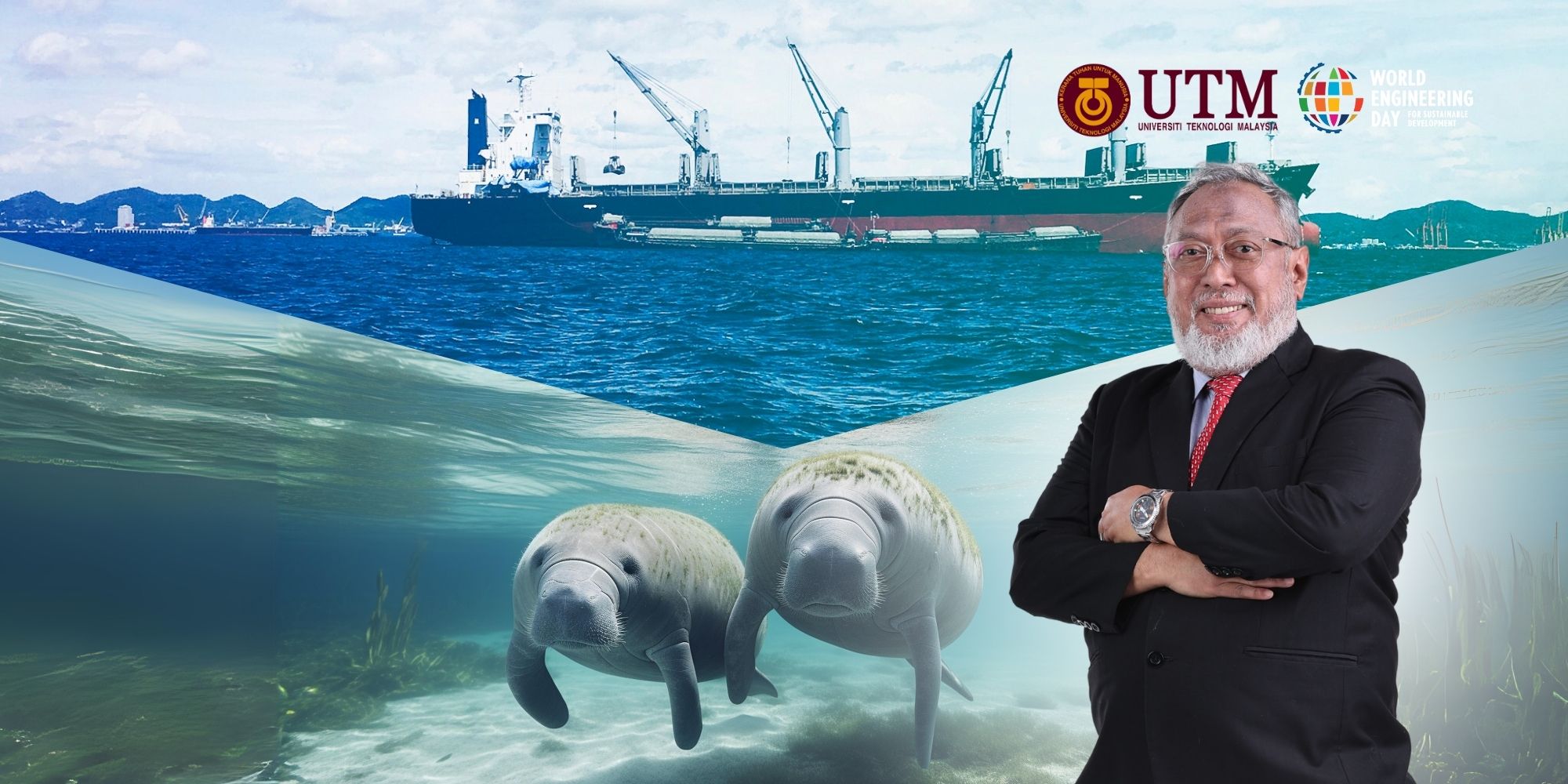Once known for its rich dugong population, the coastal Straits of Johor and its environs have undergone significant economic development with the establishment of three world-class ports, including the recently commissioned Pelabuhan Tanjung Pelepas (PTP). As a result, the coastal ecosystem in the Strait of Johor is under increasing pressure, highlighting the urgent need for advanced monitoring and management strategies to mitigate negative impacts and ensure the conservation of marine biodiversity.
In response to these challenges, the Geoscience and Digital Earth Center (INSTeG) group at Universiti Teknologi Malaysia (UTM) is using Earth Observation Satellite (EOS) data and geospatial modeling for coastal zone management. The main focus is on monitoring the seagrass habitat in the Straits of Johor to conserve the dugong population, which is already classified as endangered on the International Union for Conservation of Nature (IUCN) Red List of Threatened Species. The project aims to conduct spatio-temporal surveys of dugong populations and map habitat suitability to assess the relationship between dugong distribution, habitat characteristics and fishing pressure in the Strait of Johor. The approach includes seagrass biomass mapping, fishermen surveys and ecological modeling.
Seagrass Biomass Mapping for Dugong Conservation
Seagrass biomass mapping involves the quantification and visual representation of seagrass biomass present in an area. The process of seagrass biomass mapping involves a two-step multi-temporal Landsat satellite imagery, which includes the detection and mapping of seagrass occurrence and the determination and mapping of seagrass biomass. The purpose of seagrass biomass mapping is to extract data on water depth and biomass in the Johor Strait.
Fisher Surveys for Dugong Conservation
Fisheries surveys are data collection methods used to obtain information on fishing activity and fish populations in specific areas. The surveys usually involve interactions with fishermen or fishing communities to obtain data on fishing effort, gear types, fishing locations, catch composition and socio-economic characteristics of fishermen. Fisheries surveys are critical to the management and protection of the marine environment as they provide valuable information that helps policymakers make informed decisions about marine environmental regulation, resource allocation and conservation measures. The main objective of the fisher survey is to establish a credible dugong census.
To obtain information on dugong sightings and fishing activities along the Strait of Johor, 28 sampling sites were selected in 15 fishing villages at a distance of 0.5 to 2 km along the coasts in the east, west and south of the Strait of Johor. The dugong population was surveyed twice in 2013 and 2014 at the selected sites in two thematic areas covering the dugong population and fishing pressure.
Habitat Suitability Model for Dugong Conservation
The maximum entropy (MaxEnt) modeling technique, commonly used in biology, ecology, environmental science and other fields to infer the distribution of species based on environmental variables, was used to model the habitat suitability of dugongs. The goal is to find the probability distribution that is most widely distributed given a set of constraints typically derived from ecological data. Due to its robustness, flexibility and ability to handle complex data sets, MaxEnt has become a widely used tool in species distribution modeling. Therefore, MaxEnt was used for dugong habitat modeling based on dugong sightings off the coast of the Strait of Johor. Data on dugong presence and various environmental factors, including spatial cover of seagrass, seagrass biomass, distance to shore, water depth and land reclamation area, were used to first create a habitat suitability map, which was subsequently fed into the ecology model.
Dugong Habitat Suitability and Population in Johor Straits
Estimation of seagrass biomass has the greatest influence on habitat suitability for dugong, followed by distance from the coast, while water depth has the least influence. The most suitable habitat for dugongs is waters with a high seagrass biomass of about 20 kg/m2, 3 km from the coast and a depth of 25 m. The spatial distribution of dugongs in the Johor Strait is thus in the order of western < southern < eastern coastline. This is due to the higher fishing pressure on the western and southern coasts compared to the eastern coast. This could be related to the fact that the Johor National Park Corporation closely monitors the Mersing Islands off the east coast, which are part of the Marine Protected Area (MPA) and are more committed to conservation. Another factor could be the extensive development activities along the coast, especially in the southern region, which are not exactly conducive to the settlement of dugongs. However, improved management and conservation measures within the MPA may lead to an increase in the dugong population in the western regions.
The spatiotemporal mapping approach has successfully improved the productivity and usefulness of limited conventional techniques in many areas. This approach holds promise for addressing important dugong conservation issues, particularly in situations such as the Johor coastal strait and other similar data-poor regions. This work was mentioned in the United Nations Regional Assessment Report on Biodiversity and Ecosystem Services for Asia and the Pacific with four policy citations (https://plu.mx/plum/a/?doi=10.1016/j.marpol.2017.01.002&theme=plum-sciencedirect-theme&hideUsage=true).
More on these efforts can be found in Determination of seagrass biomass at Merambong Shoal in Straits of Johor using satellite remote sensing technique, Change Detection of Submerged Seagrass Biomass in Shallow Coastal Water (https://doi.org/10.3390/rs8030200), and Using fisher knowledge mapping population, habitat suitability and risk for the conservation of dugongs in Johor Straits of Malaysia (http://dx.doi.org/10.1016/j.marpol.2017.01.002).
Prof. Sr. Gs. Dr. Mazlan Hashim is a Professor of Remote Sensing at the Faculty of Built Environment & Surveying and a senior fellow at the Geoscience Science & Digital Earth Centre (INSTeG), UTM. Currently, he serves as the Chairman for the Council of Professors at UTM. Professor Mazlan is an expert in satellite remote sensing data processing, mapping, and modeling for environmental applications. He has published his research works in more than 140 high-impact articles with an h-index of 41 in SCOPUS and is listed in Top Research Scientists Malaysia and World Top 2% Scientists. He is a Fellow of the Academy of Sciences Malaysia and the Institution of Geospatial and Remote Sensing Malaysia.

